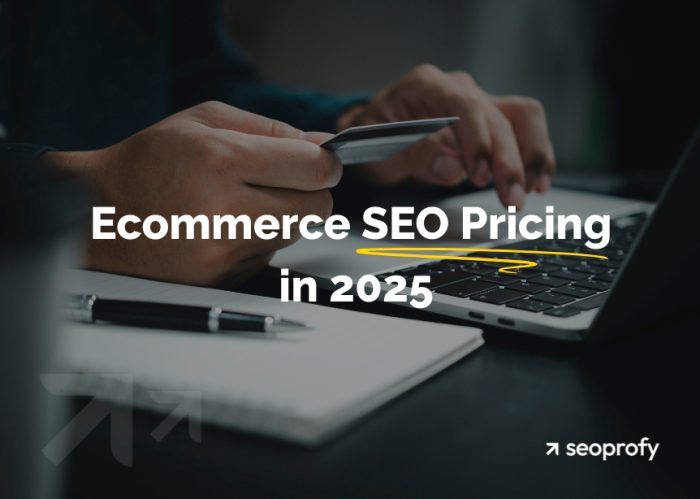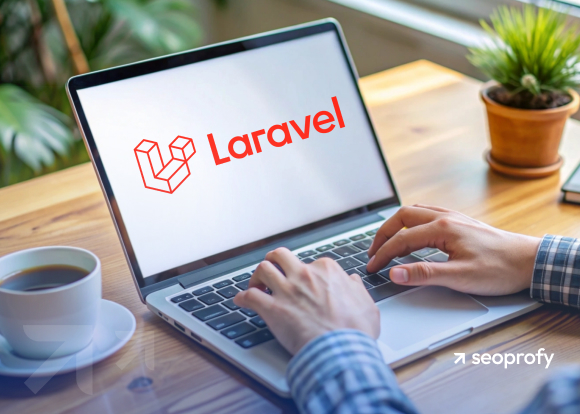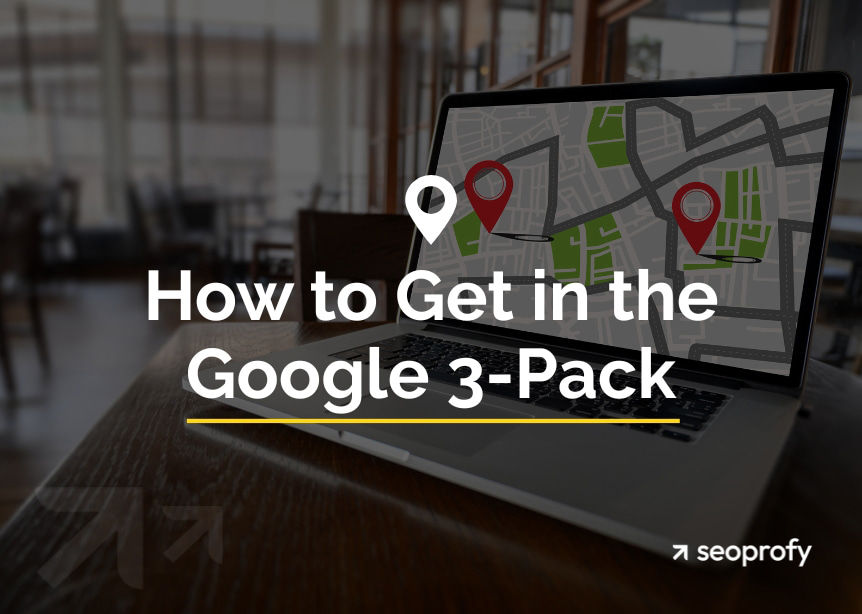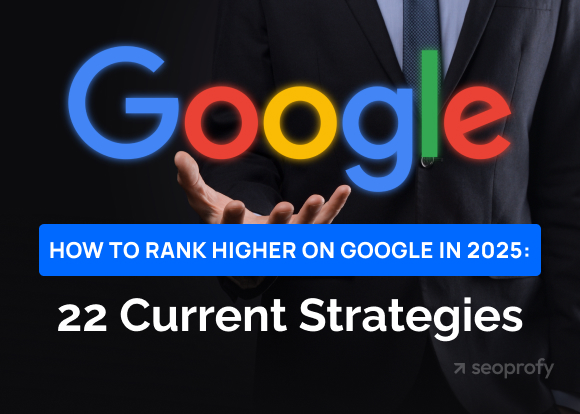Ecommerce SEO pricing can range quite a bit. Monthly retainers typically start around $1,000 and can go well beyond $15,000. One-time projects might fall anywhere between $1,000 and $200,000. What you end up paying depends on how many products you have, how competitive your market is, and how much technical or content work your site needs.
With so many different rates across the industry, it is hard to know what a reasonable SEO budget looks like. In this article, we break down the average ecommerce SEO price in detail and explain the factors behind those numbers. The goal is to help you estimate realistic costs based on your store’s specific situation.
- Most ecommerce SEO retainers start at around $1,139 per month.
- A full-scope SEO project with an agency typically costs around $37,158.
- Most agencies charge about $70 per hour for ecommerce SEO services.
- Freelancers on Upwork tend to charge slightly less, averaging $63 per hour.
Common SEO Pricing Models
There’s no one standard way to price SEO (Search Engine Optimization) services. Some agencies charge monthly, others by the hour or by the project. Some even tie pricing to results. We’ll explain the pros and cons of each model so you can figure out which one makes the most sense for your goals.
Monthly Retainers
$1,500 – $20,000
A monthly SEO retainer is a fixed-fee package where you pay an agency or freelancer to handle ongoing SEO tasks every month. It’s the most common model in the industry, especially for long-term growth.
What’s Typically Included in a Monthly SEO Package?
What’s included varies by provider. But most retainers cover a mix of on-page and off-page tasks like content updates, keyword tracking, technical health checks, and monthly performance reports.
You rarely see link building included here. Many agencies either charge per link, bundle links into monthly packages, or price based on link authority and relevance. This can include editorial placements, niche edits, or outreach-based link acquisition.
So, what do you actually get for your monthly fee? Many agency sites feature package breakdowns, but the real value is in the fine print. Look closely at what’s included. Most ecommerce website SEO packages are scoped around clear deliverables. For example, a basic plan might include tracking 20 pages, publishing 2 content updates, and running 1 monthly full audit. Getting your ecommerce site indexed properly is often part of that initial scope, especially for large catalogs.
Worried about choosing the wrong tier? This isn’t a marketplace where you pick a plan, drop it in your cart, and check it out. When you click a button like “Select Plan,” you are basically sending a request for a consultation. That’s how the SEO company learns about your goals and recommends the right fit.
Some agencies skip packages entirely and offer custom quotes only. Their thinking is that every business is unique, so predefined scopes will never reflect the actual work required.
Monthly Retainers: Pros and Cons
Although monthly retainers are one of the most common ways SEO services are priced, that doesn’t mean they’re perfect for everyone. Here’s a quick look at what they do well and where they can fall short:
Pros:
- Clear monthly budgeting
- Easier to align technical, content, and on-site work under one strategy
- Ideal for ongoing needs like content optimization, crawlability fixes, and site health monitoring
- Improves performance gradually as the team gets more familiar with your goals and technical setup
Cons:
- Fixed deliverables may not keep pace with sudden changes like seasonal campaigns or urgent product launches
- Link building is usually a separate cost or handled through an additional package
- Results may plateau if the scope doesn’t evolve with your site’s growth
Average Ecommerce SEO Monthly Pricing
Now to the part everyone wants to know: how much does a monthly ecommerce SEO retainer actually cost?
We analyzed pricing pages from 346 SEO agencies. Here’s what we found: the average starting price for a monthly SEO retainer is $1,139. Let’s break down the full pricing range based on our research:
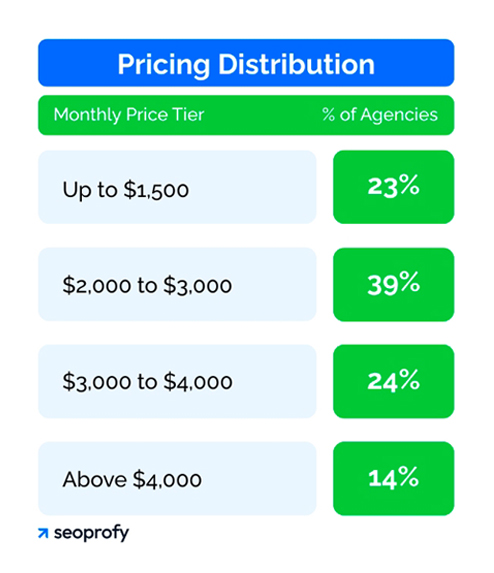
| Pricing Distribution | |
| Monthly Price Tier | % of Agencies |
| Up to $1,500 | 23% |
| $2,000 to $3,000 | 39% |
| $3,000 to $4,000 | 24% |
| Above $4,000 | 14% |
Why such a wide range? Because every agency builds its ecommerce website SEO packages differently. Some bundle technical SEO, audits, reporting, and consulting. Others focus just on content optimization. And since these agencies are located all over the world, pricing reflects both location and perceived quality.
These numbers reflect starting prices. If you run an ecommerce site, those entry-level packages might not be enough. You’re likely dealing with dozens of category pages, hundreds of products, and regular updates across the board. In most cases, this calls for a mid-tier or custom plan. So treat these numbers as the bare minimum for getting consistent SEO support.
The final cost depends on your site’s size, technical complexity, and growth targets. If you’re serious about scaling your ecommerce business, the SeoProfy team can calculate a tailored Ecommerce SEO services plan based on a site audit and your goals.
Project-Based SEO
$5,000 – $20,000 avg.
Project-based pricing is a fixed-cost model where you pay for a specific outcome, not ongoing support. The scope is clearly defined upfront, and the agency completes the work within an agreed timeline.
What’s Included in Project-Based SEO
In ecommerce SEO, this model often includes full technical audits, complex site migrations, keyword research from scratch, or complete SEO setup for new stores.
It can also be useful in situations where you need targeted help. For example, when you are preparing a new product collection for launch and want the pages optimized before going live. Or when technical issues start affecting performance, but no one on your team has the skills to handle structured data, crawl budget management, or redirect mapping.
New businesses often use project-based SEO to fix the basics before investing in a full strategy. That might include resolving indexation issues, improving site architecture, setting up analytics and Search Console, and building an initial keyword list.
To get the most out of your SEO investment, it helps to know exactly what impacts your results. Use our comprehensive ecommerce SEO guide to build the structure your store actually needs.
Pros and Cons
This model works well in many situations but is not for everyone. Here are the pros and cons.
Pros:
- Clear deliverables and pricing for SEO from the beginning
- Effective for solving specific issues or closing internal skill gaps
Cons:
- No support after the project ends
- Hard to adjust if goals change midway
- Does not support long-term gains unless followed by additional work
Average Ecommerce Project-Based SEO Pricing
After analyzing over 65,000 agency listings, Clutch found that most SEO projects listed on their platform cost less than $10,000. But what’s the average SEO cost for a project with an agency? It runs around $37,158.66.

These projects typically last about a year, which means businesses pay around $3,199.19/month. However, the final price always depends on complexity. A quick site audit might cost under $2,000 and take just a few days. A full migration or major technical repair can go over $15,000 and last several months.
Hourly SEO Rates
Hourly Ecommerce SEO pricing is a payment model where you are charged for each hour an expert spends working on a specific SEO task. It is a flexible option when you want to delegate a single, clearly defined job without committing to a full scope.
What’s Typically Billed Hourly
This model is common when working with freelance SEO specialists, consultants, or agencies that handle ongoing requests. Businesses use it for tasks like technical troubleshooting, reviewing content before it goes live, cleaning up crawl issues, or consulting sessions. So, anything that does not require a full scope but still needs expert input can be billed hourly.
Pay-Per-Hour Payment Model: Pros and Cons
Flexibility is just one reason businesses choose hourly pricing. Here are a few more things to consider:
Pros:
- Pay only for what you use
- Great for technical fixes or quick consulting
- No contracts or upfront commitments
Cons:
- Hard to control the final cost if the scope grows
- No guarantee of long-term involvement or strategy
- Not ideal for large or ongoing SEO projects
Average Ecommerce SEO Hourly Rates
We analyzed hourly SEO rates from 10,758 companies offering services for ecommerce businesses. The average hourly rate came out to $82. Here is the pricing breakdown across the industry:
| Price Range | Company Count | Share |
| Less than $25 | 500 | 3% |
| $25–$49 | 1,500 | 9% |
| $50–$99 | 1,900 | 11% |
| $100–$149 | 2,000 | 12% |
| $150–$199 | 3,400 | 20% |
| $200–$300 | 5,700 | 34% |
| Over $300 | 2,000 | 12% |
| Total | 17,000 | 100% |
In contrast, the average hourly rate for ecommerce SEO freelancers on Upwork is slightly lower, around 63$:

But with freelancers, it can be hard to tell what level of quality you are actually getting. Be cautious with Upwork reviews — some can be inflated. Vet profiles carefully by asking for specific case studies and performance metrics.
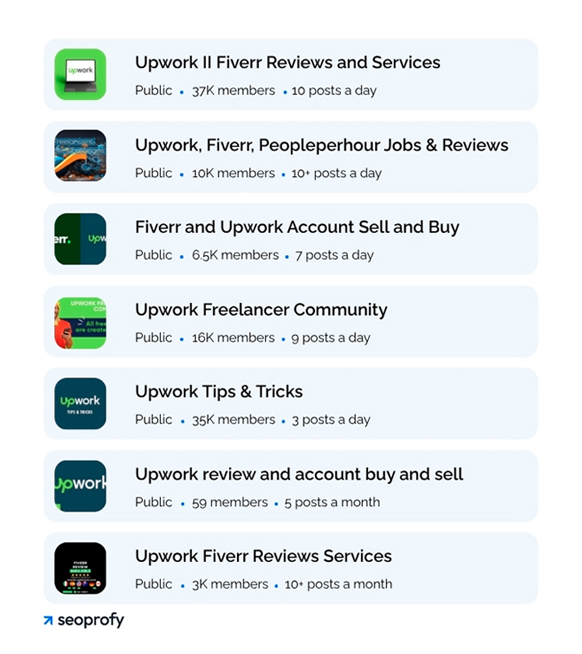
Back to agencies. A more accurate view comes from looking at average rates by service, since pricing varies significantly depending on what is being done. Here is what we found:
| Service | Average Hourly Pricing | Based on: |
| Content services | $74.80/hour | 2,804 companies |
| Market research | $77.26/hour | 203 companies |
| Conversion optimization | $80.51/hour | 1,366 companies |
| Link building | $70.70/hour | 956 companies |
| Site migration | $81.79/hour | 956 companies |
| Technical SEO fixes | $82.28/hour | 10,266 companies |
Performance-Based SEO
Performance-based SEO is a pricing model where the agency earns compensation only after meeting clearly defined results. These results typically focus on rankings, organic traffic, or revenue growth. Instead of paying for time or tasks, the client pays for outcomes that directly support business goals.
How It Works
Pure performance-based SEO remains uncommon in ecommerce, but hybrid models with base retainers and performance bonuses are gaining traction. Most agencies avoid it because even strong execution cannot guarantee results if the site has technical debt, low-converting product pages, or external factors like supply chain disruptions. These variables fall outside the agency’s control but directly affect success.
Instead, a more realistic option is a hybrid model. Instead of going all-in on performance, the client pays a base monthly retainer to cover essentials like technical work, reporting, and strategic planning, with performance bonuses tied to specific KPIs. This allows both sides to share responsibility and align incentives without putting either party at a disadvantage.
What Is Usually Measured and Why It Matters
So, performance-based models rely on clear, trackable KPIs. However, not all metrics reflect real business value. Here are the most common ones, and what to watch out for in each case.
- Keyword rankings. Easy to track but misleading without context. A top ranking means little if the query has low intent or the page fails to convert. This metric works best when tied to transactional keywords.
- Organic traffic. A more accurate reflection of visibility, but still not enough on its own. A spike in informational traffic may look impressive but bring no sales. You need to segment the traffic by intent.
- Revenue or sales. The most meaningful outcome for ecommerce, but difficult to attribute precisely. Organic traffic may assist conversions without being the final click. You need multi-touch attribution in place to assess real impact.
- Leads or sign-ups. Useful for ecommerce models that rely on email capture, quote requests, or lead nurturing. But volume alone does not equal value. Lead quality should be part of the evaluation.
- Click-through rate (CTR). Sometimes used when rankings are stable but clicks are low. Improving titles and meta descriptions can lift performance, but CTR is sensitive to many external factors, including search engine results pages layout and brand familiarity.
Pros and Cons
And to wrap it up, let’s outline the pros and cons of this approach. Here are the key points:
Pros:
- You pay based on actual results
- Agency and client incentives are aligned
- Lower initial cost if using a pure performance model
Cons:
- Very few agencies offer this, especially for ecommerce
- Performance depends on factors beyond SEO alone
- The scope is often limited to what is easy to measure
- Not well suited for long-term brand building or technical overhauls
Why Ecommerce SEO Requires More Resources
Unlike other types of websites, ecommerce ones operate at a different scale and speed. The sheer volume of URLs increases the SEO workload significantly. On top of that, the frequency of updates creates constant pressure on both technical and content operations.
Take nike.com as an example. The site has millions of indexed pages, covering product variations, reviews, seller listings, and discontinued items. It updates constantly. Here are the estimates Google gives us (it often overstates or understates) for the number of indexed Nike pages:

New SKUs are added every second. Availability and pricing change by the minute. Search visibility at that scale requires continuous monitoring, refinement, and correction.
Now compare that to a software company site or a service-based business like a law firm. They might have under 50 pages in total, with updates a few times per quarter. For example, here’s the Latham&Watkins law firm’s full sitemap: Such websites might change content only when regulations shift or a new location opens. In those cases, SEO means occasional improvements and positioning, not daily maintenance.
Ecommerce SEO requires a different level of commitment. Here is what that usually involves:
- Content production at scale. Product, collection, and blog pages often need hundreds of optimized briefs. Each one must match search intent, reflect the offer accurately, and support conversions.
- Recurring technical audits. Dynamic elements introduce crawl errors, index bloat, broken links, or incorrect canonicals. These issues return over time unless managed proactively.
- Structured data upkeep. Review markup, product schema, and inventory signals must remain complete and accurate. If something breaks, the result is lost visibility in search features.
- Link profile cleanup. Ecommerce domains attract harmful links from scrapers, coupon sites, or low-quality affiliates. These need regular review and disavowal to protect rankings. And then, of course, quality and scalable link building for ecommerce.
- Inventory-driven URL management. As stock changes, URLs go live, go out of stock, get redirected, or get reused. SEO must work closely with merchandising to handle all of that correctly.
Moreover, this is not something that can be set up once and left alone. And that’s exactly why ecommerce SEO tends to cost more. You are not just paying for expertise. You are paying for the capacity to handle scale, speed, and constant change.
How Pricing For SEO Varies by Business Size, Complexity, Competition Level, and State of SEO
By now, it’s clear that pricing depends heavily on the size of your ecommerce site. A store with 50 URLs will naturally require fewer resources than one with 5,000. But scale isn’t the only factor. Let’s look at three others that influence the final budget just as much.
Site Complexity
Some ecommerce sites are built on simple platforms with standard templates and minimal custom code. Others have layered filtering, international versions, a custom CMS, or technical debt that’s built up over the years. The more complex the site, the more time is spent just keeping things functional. Every change needs to be tested, coordinated, and revisited as the site evolves.
How Competitive Your Niche Is
Fast fashion is one of the most competitive spaces in ecommerce. Brands like Zara, H&M, ASOS, and Shein launch new campaigns every week, push out fresh content constantly, and invest in every available channel.
If you’re trying to rank in that space, your SEO strategy needs to be just as active and consistent. But if you’re selling hand-dyed linen shirts to a niche audience, the pressure is different. There are fewer players and slower content cycles, so you may be able to get strong results with a smaller investment.
Your Current SEO Baseline
Some businesses are starting from zero. No proper structure, no keyword targeting, no analytics. Others come in with content already in place, decent rankings, or just a few areas that need cleanup. The gap between these two starting points is huge. And it directly affects how much of your budget needs to go into fixing before anything can grow.
So, a smaller skincare brand, selling in one market with a focused catalog and a clean technical setup, or just a few minor issues to fix, might work well with a $3,000 monthly budget. That covers strategic oversight and monitoring without the need for heavy technical hours or aggressive link building.
On the other end, a large fashion retailer selling across multiple countries, with daily product updates, layered site architecture, legacy platform constraints, and frequent indexing issues may require 10,000 dollars or more per month. A big part of that budget goes into keeping the site stable, adapting content at scale, managing international SEO, and protecting visibility in highly competitive SERPs.
High Fashion E-commerce Considerations
We decided to give specialized fashion ecommerce SEO its own section because it comes with nuances that can’t be ignored. High-fashion ecommerce SEO plays by different rules — and the expectations for branding and polish are much higher.
Sites like Net-a-Porter, SSENSE, and Farfetch don’t compete on volume. They curate exclusive collections and focus on creating a brand-driven shopping experience, where every SERP result, review snippet, and landing page must reflect prestige and precision.
Branding
These brands aim to control their entire branded search space. That means dominating the first page of results with clean, on-brand content—including their site, media mentions, influencer reviews, and stockist listings. SEO strategy here often overlaps with online reputation management, PR-driven link acquisition, and branded SERP shaping.
Take Jacquemus.com as an example. The site has a small number of SKUs, yet each product page is rich in storytelling and aligned with the brand’s visual identity. SEO here is not about chasing long-tail terms — it’s about protecting and amplifying brand presence.

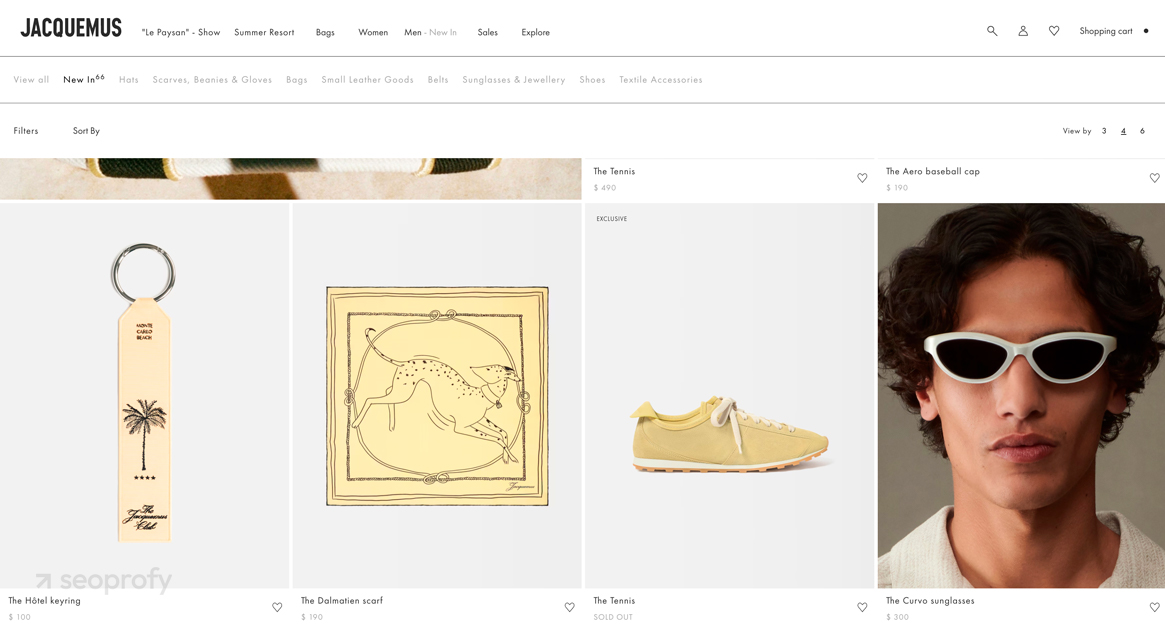
This changes the way optimization is approached:
- Technical SEO must work within custom, design-heavy templates.
- Meta titles are treated like ad copy.
- Content production is slower, more controlled, and more collaborative, often involving legal, merchandising, and brand teams.
Technical Optimization
That same precision applies to technical execution as well. These sites are visually complex. They rely on large imagery, custom animations, and layouts built around mood and style, not templates.
SEO has to account for that. Recommendations must be precise, lightweight, and fully compatible with the creative direction. That often means working side by side with the development team, not just handing off a list of issues.
Want to learn more about technical optimization for fashion websites? Consider this guide, where we break it down in detail.
Content
Content also takes longer. One product description might go through legal, editorial, brand, and merchandising before it’s approved. The tone must be exact, with meta tags reviewed like ad copy.
While the scope may seem smaller on paper, every task is deeper, slower, and more resource-intensive. That’s why pricing for high-fashion SEO tends to be significantly higher.
Budgeting for SEO: Actionable Insights for Fashion Brands
Setting an SEO budget starts with knowing where your business is. A brand that is pre-launch needs a different strategy than one scaling internationally.
Early Stage
- The estimated monthly budget starts at $3,000
At the early stage, the focus is usually on technical foundation, crawling and indexing, and preparing key category pages. You need to be discoverable, not dominant.
Typical scope at this stage includes auditing the site structure, configuring analytics and product feeds, and optimizing a small group of high-priority pages. These are often the most important category or product pages that drive early conversions. Optimization usually happens in batches. Instead of working on the entire site at once, SEO teams start with the most strategic sections and expand over time.
At this stage, publishing blog content just for the sake of activity rarely delivers results. If content is part of your strategy, make sure you have a documented plan that ties into your business goals. These blog strategy ideas can help find that direction.
Growth Phase
- The typical monthly budget starts at $5,000
During the growth phase, the budget expands to include content development, structured internal linking, authority-building campaigns, and ongoing audits. At this point, SEO should be integrated with performance marketing and product development. You are building depth and consistency across searches.
Brands in this phase typically expand optimization to 10–15 product pages per month, starting with top-performing items and gradually moving down the catalog. They also begin targeting new keyword segments and investing in building a content strategy for ecommerce, targeting both discovery and conversion.
Established Brands
- Monthly budgets usually start at $10,000
Established brands often invest more in competitive research, product-level optimization, testing page templates, and expanding into new search verticals like video or shopping feeds. This is where the SEO budget supports channel diversification and long-term visibility.
Work at this stage usually includes optimization for dozens of products per month, content production of 4,000+ words, several branded videos, original design assets, link building, and extensive keyword tracking across multiple categories.
At any stage, your SEO investment should match your current business goals. Focus on what actually drives growth: technical cleanup, strategic content, and link acquisition. Avoid spreading your budget thin across low-impact activities.
A smart SEO budget isn’t defined by how much you spend. It’s defined by how well your investment matches the work your site needs.
Emerging SEO Pricing Trends and ROI Frameworks
Throughout this guide, we’ve talked a lot about SEO budgets. But knowing what to invest in is only half the equation. The other half is understanding what you might get in return.
In ecommerce, SEO ROI refers to how much revenue your organic traffic generates compared to what you spend to get it. Rankings and traffic are part of the picture, but what really matters is how those visitors turn into actual sales through search visibility, product discovery, and on-site conversion.
To make sense of this, you can use a simple calculator that models potential outcomes. This ecommerce SEO ROI calculator lets you input your current traffic, average order value, margins, and SEO spend. It gives you an estimate of how your investment might pay off over time.
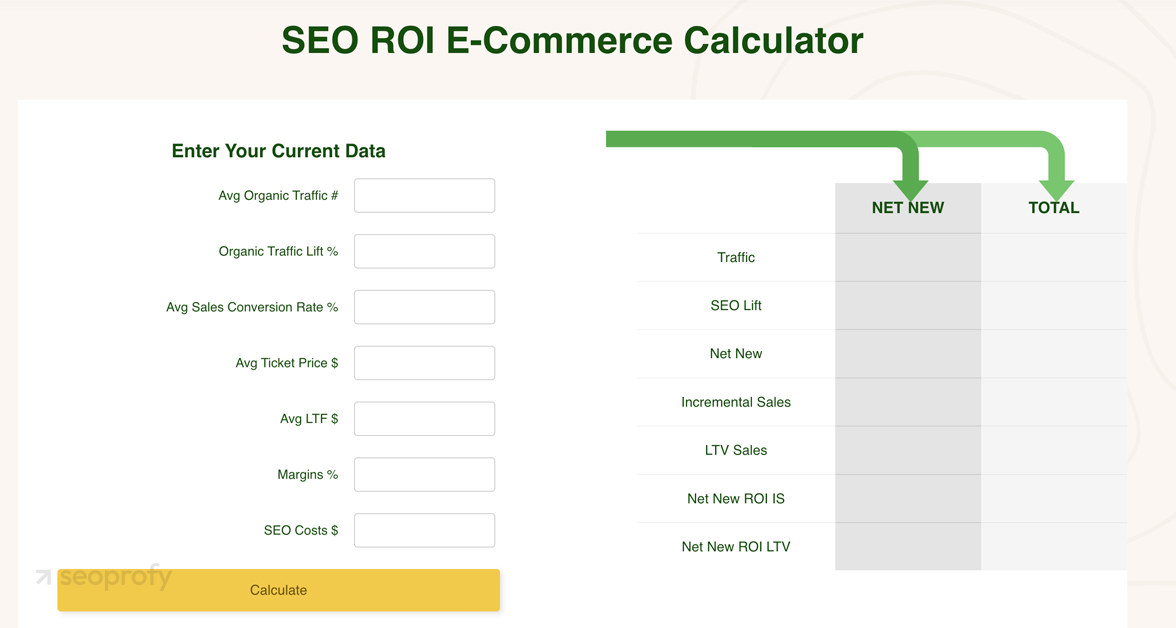
Let’s walk through a quick example. Imagine your store gets around 25,000 organic visits a month. You expect a 30% traffic lift from SEO. Your average conversion rate is 1.5%, average order value is $110, and lifetime value per customer is $220. Your margins are about 40%, and you’re planning to invest $5,000 per month in SEO.
Based on this input, the calculator shows how long it might take to break even and when you can expect to see a return. It helps you understand what kind of performance you need for the investment to make sense.
You can adjust the inputs to reflect your real margins, expected improvements, or seasonal demand. It won’t give you exact predictions, but it helps anchor your strategy to real outcomes.
Conclusion
You now have clear benchmarks to estimate how much SEO might cost based on your current stage. These are helpful for planning, but they are still just estimates. The real scope always depends on your product catalog, internal resources, and how competitive your market is.
At SeoProfy, we specialize in ecommerce SEO and understand how to prioritize what brings actual results. We help brands optimize ecommerce product pages, improve category structure, and grow visibility across high-intent searches.
If you are looking for an SEO strategy that reflects your business goals and adapts to your real market, we can help you map it out. Get in touch for a free consultation!

